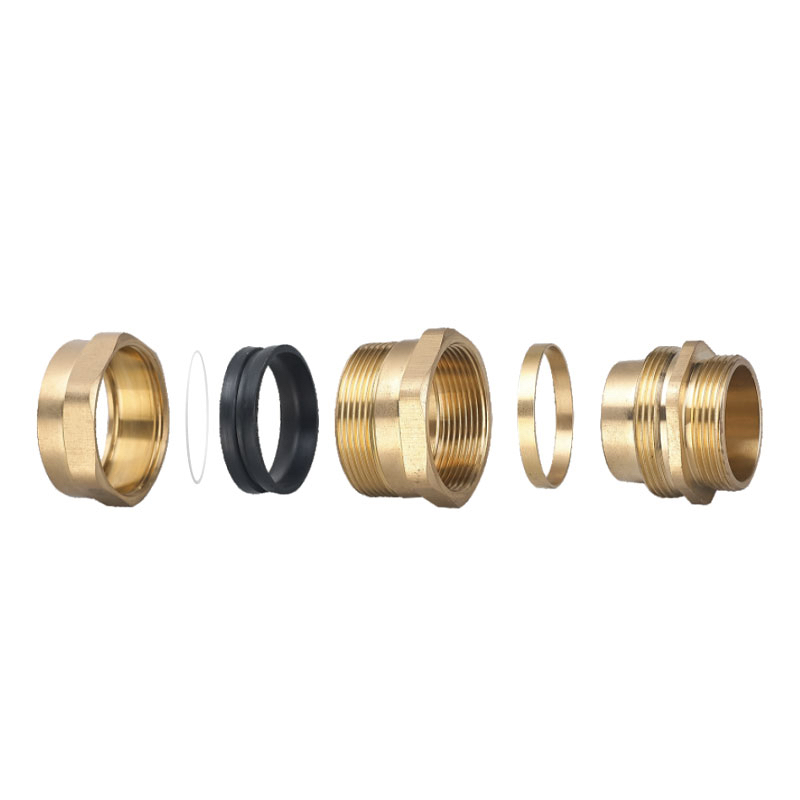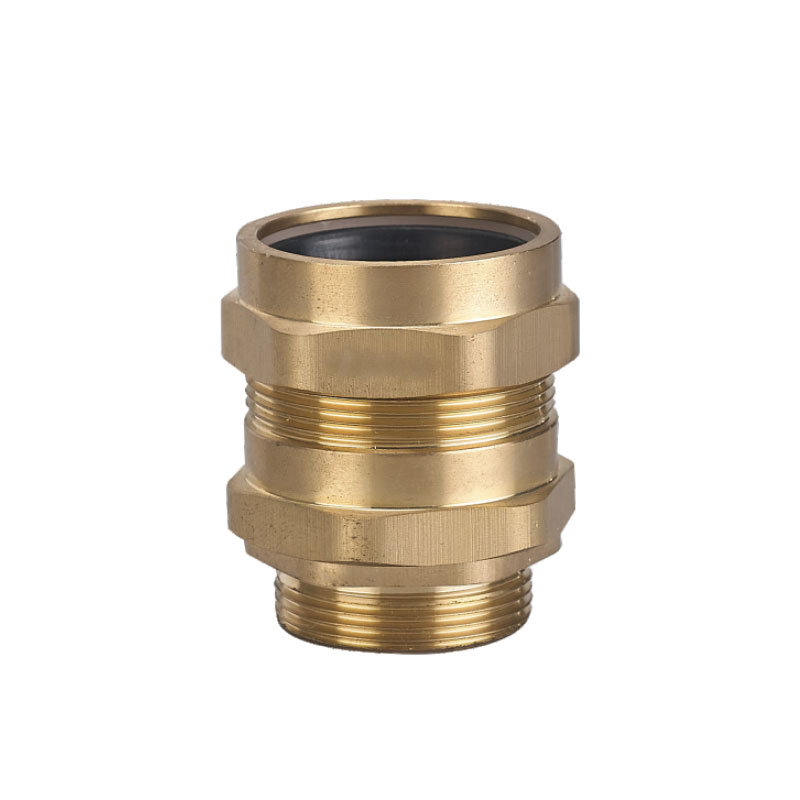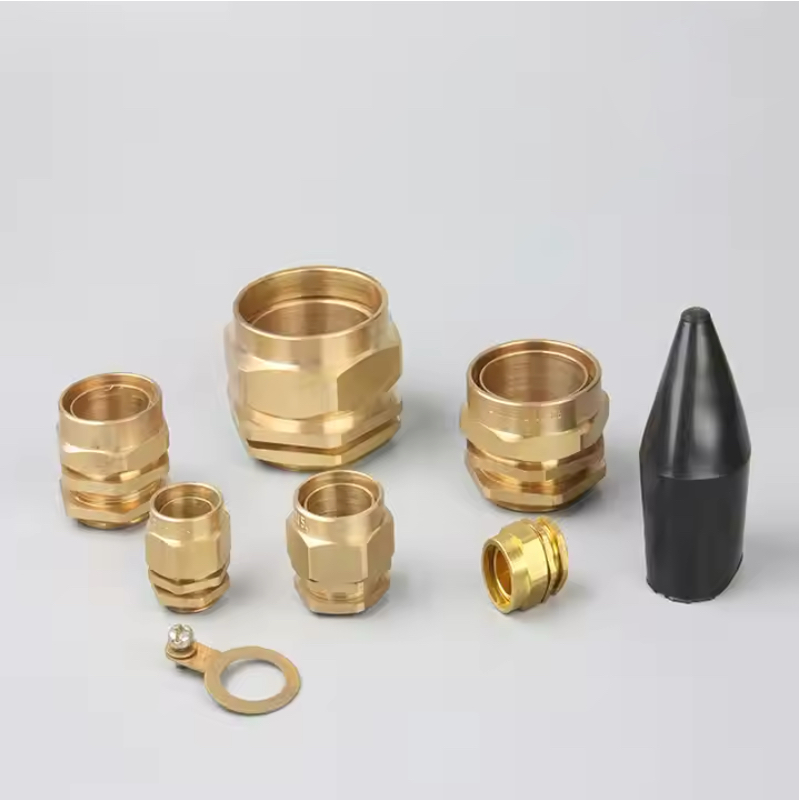Understanding the intricate construction of A2 type brass cable glands is crucial for engineers and procurement managers who need reliable cable termination solutions. Many professionals struggle with selecting the right cable gland specifications without fully understanding the internal construction and how each component contributes to overall performance.
A2 型黃銅電纜接頭具有堅固耐用的多元件結構,包括具有公制螺紋的黃銅主體、壓縮密封系統、應變釋放機制和整合式接地連續性,專為需要長期可靠性的工業應用而設計,具有 IP68 環境保護和機械耐用性,適用於鎧裝電纜端接。.
Just last month, Robert, a project engineer from a manufacturing facility in Birmingham, UK, contacted me after experiencing seal failures with inferior cable glands. His team needed to understand the precise construction differences between A2 type brass glands and standard versions to prevent costly equipment downtime in their automated production lines 😉
目錄
- What Makes A2 Type Brass Cable Glands Unique?
- How Are the Key Components Constructed?
- What Materials and Manufacturing Processes Are Used?
- How Does the Sealing System Work?
- What Are the Quality Standards and Testing Requirements?
- FAQs About A2 Type Brass Cable Gland Construction
What Makes A2 Type Brass Cable Glands Unique?
The A2 designation represents a specific construction standard that differentiates these cable glands from other types in terms of design philosophy and application focus.
A2 type brass cable glands are specifically engineered for armored cable termination with enhanced mechanical strength, featuring a specialized construction that includes armor clamping mechanisms, extended thread engagement, reinforced body design, and superior earthing continuity1 compared to standard cable glands, making them ideal for heavy-duty industrial applications.
Design Philosophy and Standards
A2 Construction Standards:
- Enhanced mechanical strength requirements
- Specialized armored cable accommodation
- Extended service life specifications
- Superior environmental protection ratings
- Integrated earthing and bonding capabilities
Key Differentiating Features:
- Reinforced body wall thickness (minimum 2.5mm)
- 延長螺紋齧合長度
- Specialized armor clamping system
- Enhanced sealing performance
- 優異的耐腐蝕性
Construction Specifications
| 組件 | A2 Type Specification | Standard Type |
|---|---|---|
| Body Wall Thickness | 2.5-4.0mm | 1.5-2.5mm |
| 主題訂婚 | 8-12 threads minimum | 5-8 threads |
| Sealing Rings | Dual compression system | Single seal |
| 裝甲夾具 | Integrated design | Optional/separate |
| 材質等級 | CW617N/CW614N2 | CW617N standard |
| IP 等級 | IP68 guaranteed | IP65-IP67 typical |
Application-Specific Design Elements
Armored Cable Optimization:
- Specialized armor wire accommodation
- Integrated armor clamping mechanism
- Enhanced strain relief design
- Superior earthing continuity
- Mechanical protection features
Industrial Environment Adaptation:
- Vibration resistance construction
- Temperature cycling durability
- 耐化學特性
- UV stability for outdoor use
- 耐機械衝擊性
性能優勢
Enhanced Reliability:
- 25+ year service life expectation
- Superior environmental sealing
- 降低維護需求
- Consistent performance under stress
- 可預測的故障模式
營運效益:
- Simplified installation procedures
- Reduced inventory complexity
- 降低總擁有成本
- 提高系統可靠性
- Enhanced safety performance
At Bepto, our A2 type brass cable glands undergo rigorous quality control processes in our CNC machining facilities. We maintain strict dimensional tolerances and material specifications to ensure consistent performance across all production batches.
How Are the Key Components Constructed?
Each component of an A2 type brass cable gland serves a specific function and requires precise manufacturing to achieve optimal performance.
A2 type brass cable glands consist of seven primary components: the main body with metric threads, compression nut, sealing washers, compression cone, armor clamp ring, earthing tag, and strain relief boot, each manufactured to precise tolerances using specialized machining processes and quality-controlled brass alloys for maximum durability and performance.

Main Body Construction
Body Design Features:
- CNC-machined from solid brass bar stock
- Metric thread specification (M12-M75 range)
- Integrated sealing surfaces with precise finish
- Internal cable accommodation chamber
- Armor wire termination area
製造過程:
- Computer-controlled turning operations
- Thread rolling for superior strength
- Surface finishing to Ra 1.6 specification
- Dimensional inspection at multiple stages
- Final assembly preparation
Compression System Components
Compression Nut Design:
- Hexagonal external profile for tool engagement
- Internal compression thread system
- Integrated sealing surface preparation
- Torque specification optimization
- Anti-seizing surface treatment
Sealing Washer Construction:
- EPDM rubber compound selection
- Shore A hardness 70±5 specification
- Temperature range -40°C to +125°C
- 耐化學特性
- 壓縮設定阻力
Armor Clamping Mechanism
Armor Clamp Ring Features:
- Serrated internal surface for wire grip
- Tapered design for compression action
- Corrosion-resistant surface treatment
- Precise dimensional control
- Integration with earthing system
Earthing Tag Construction:
- Brass or stainless steel material
- M4 or M5 earthing screw provision
- Low-resistance electrical path
- Corrosion protection coating
- Mechanical strength verification
Strain Relief System
Boot Design Elements:
- Flexible elastomer material selection
- Graduated flexibility zones
- Cable diameter accommodation range
- Environmental protection properties
- Long-term durability characteristics
性能規格:
- Bend radius protection: 6x cable diameter
- Temperature stability: -40°C to +100°C
- UV resistance for outdoor applications
- Oil and chemical resistance
- Fatigue resistance testing
品質控制措施
組件檢查:
- Dimensional verification using CMM
- 材料成分分析
- 表面光潔度測量
- Thread gauge verification
- Assembly fit testing
性能驗證:
- Torque testing for proper assembly
- Sealing performance verification
- 電氣連續性測試
- Environmental exposure testing
- Long-term durability assessment
Ahmed, who manages electrical installations for a petrochemical facility in Dubai, UAE, required detailed component specifications for his ATEX Zone 1 applications. Our engineering team provided comprehensive construction drawings and material certificates, enabling his team to achieve full regulatory compliance with superior long-term performance.
What Materials and Manufacturing Processes Are Used?
The selection of materials and manufacturing processes directly impacts the performance, durability, and cost-effectiveness of A2 type brass cable glands.
A2 type brass cable glands utilize CW617N or CW614N brass alloys for the main body, providing excellent corrosion resistance and machinability, with EPDM sealing materials, stainless steel hardware, and specialized surface treatments, manufactured using precision CNC machining, thread rolling3, and automated assembly processes to ensure consistent quality and performance.
Primary Material Selection
Brass Alloy Specifications:
- CW617N (58% copper, 39% zinc, 2% lead)
- CW614N (58% copper, 39% zinc, 3% lead)
- Excellent corrosion resistance properties
- Superior machinability characteristics
- Optimal strength-to-weight ratio
材料特性:
- Tensile strength: 380-420 MPa
- Yield strength: 140-180 MPa
- Elongation: 15-25%
- Hardness: 80-120 HB
- Electrical conductivity: 26-28% IACS
Sealing Material Technology
EPDM Rubber Characteristics:
- Ethylene Propylene Diene Monomer base
- Shore A hardness 70±5
- Temperature range: -40°C to +125°C
- Excellent ozone resistance
- Superior weathering properties
Alternative Sealing Materials:
- NBR for oil resistance applications
- Viton for chemical resistance
- Silicone for extreme temperatures
- TPE for food-grade applications
- Custom compounds for specific needs
Manufacturing Process Overview
CNC Machining Operations:
- Computer-controlled turning centers
- Multi-axis machining capabilities
- Automated tool changing systems
- Real-time dimensional monitoring
- 統計流程控制
Thread Manufacturing:
- Thread rolling for superior strength
- Precise pitch and profile control
- 表面光潔度最佳化
- 尺寸精度驗證
- Thread gauge inspection
Surface Treatment Processes
腐蝕防護:
- Nickel plating for enhanced durability
- Chromium plating for wear resistance
- 鈍化處理
- Organic coating systems
- Specialized marine coatings
Quality Enhancement:
- Surface roughness control
- Dimensional stability improvement
- Appearance standardization
- 效能最佳化
- 長期耐用性
Quality Assurance Systems
材料認證:
- Mill test certificates for all materials
- Chemical composition verification
- Mechanical property testing
- 可追蹤性文件
- 供應商資格認證計劃
製程控制:
- Statistical process monitoring
- Automated inspection systems
- 持續改善計畫
- 糾正行動程序
- 客戶回饋整合
At Bepto, we maintain strict material traceability from raw material receipt through final product delivery. Our ISO9001 and IATF16949 certifications ensure consistent quality and continuous improvement in our manufacturing processes.
How Does the Sealing System Work?
The sealing system is the most critical aspect of A2 type brass cable gland construction, determining environmental protection and long-term reliability.
A2 type brass cable glands employ a dual-compression sealing system featuring primary cable sealing through radial compression of EPDM washers against the cable jacket, and secondary environmental sealing via thread-mounted O-rings, creating IP68 protection through controlled compression forces that maintain seal integrity across temperature variations and mechanical stress.
Primary Sealing Mechanism
Cable Jacket Sealing:
- Radial compression against cable outer jacket
- 周圍均勻的壓力分佈
- Accommodation of cable diameter variations
- Compensation for thermal expansion/contraction
- Long-term seal integrity maintenance
Compression Force Control:
- Calculated compression ratios for optimal sealing
- Torque specifications for consistent results
- Over-compression prevention mechanisms
- Under-compression indication systems
- Field verification procedures
Secondary Environmental Sealing
Thread Sealing System:
- O-ring seals in thread engagement area
- Protection against ingress through threads
- Redundant sealing for critical applications
- Maintenance accessibility features
- 長期效能穩定
Sealing Performance Characteristics:
- IP68 rating verification testing
- Pressure resistance up to 10 bar
- 溫度循環性能
- 耐化學特性
- UV degradation resistance
Sealing Material Performance
EPDM Sealing Properties:
- 優異的抗壓縮性
- Wide temperature operating range
- Superior ozone and weather resistance
- Chemical compatibility with most cables
- Long-term aging characteristics
效能測試:
- Accelerated aging tests at elevated temperatures
- Compression set testing per ASTM D395
- 耐化學性評估
- UV exposure testing
- Thermal cycling verification
Installation Critical Factors
Proper Assembly Techniques:
- 電纜準備要求
- Sealing washer positioning
- Compression nut torque specifications
- 目視檢查標準
- Performance verification methods
常見的安裝錯誤:
- Insufficient cable preparation
- Incorrect sealing washer orientation
- Over-tightening causing seal damage
- 組裝期間的污染
- Inadequate performance verification
Maintenance and Service Life
Seal Inspection Requirements:
- Visual inspection for damage or degradation
- Torque verification procedures
- Performance testing methods
- 更換標準和程序
- 文件要求
Expected Service Life:
- 20+ years under normal conditions
- 15+ years in harsh environments
- 10+ years in extreme chemical exposure
- Temperature cycling impact assessment
- Predictive maintenance indicators
The sealing system design has been validated through extensive testing at our facilities, including 1000-hour salt spray exposure, thermal cycling from -40°C to +125°C, and long-term compression set testing to ensure reliable performance throughout the product lifecycle.
What Are the Quality Standards and Testing Requirements?
A2 type brass cable glands must meet stringent quality standards and undergo comprehensive testing to ensure reliable performance in demanding applications.
A2 type brass cable glands must comply with IEC 62444, IP68 environmental protection standards, ATEX directive requirements for hazardous areas, and various national standards including BS, DIN, and ANSI specifications, with mandatory testing including ingress protection verification, mechanical strength testing, corrosion resistance evaluation, and electrical continuity measurement to ensure consistent quality and performance.
符合國際標準
Primary Standards:
- IEC 62444:電氣裝置用電纜接頭
- IEC 60529: IP protection degree classification
- IEC 60079: Explosive atmospheres equipment
- ISO 9001: Quality management systems
- IATF 16949: Automotive quality standards
Regional Standards:
- BS EN 50262: European cable gland standards
- DIN VDE 0619: German electrical installation standards
- ANSI/UL 514B: North American conduit fittings
- JIS C 8480: Japanese electrical equipment standards
- GB/T 5095: Chinese connector standards
Mandatory Testing Procedures
Environmental Protection Testing:
- IP68 ingress protection verification
- Continuous immersion testing (1m depth, 24 hours)
- Dust ingress prevention testing
- 溫度循環性能
- 耐濕性評估
Mechanical Performance Testing:
- Tensile strength testing (minimum 500N)
- Torque resistance verification
- 耐衝擊測試
- Vibration endurance testing
- Fatigue cycle testing
Material Quality Verification
Chemical Composition Analysis:
- Spectroscopic analysis of brass alloys
- Lead content verification for RoHS compliance
- Trace element identification
- Material certification documentation
- Supplier qualification verification
機械特性測試:
- Tensile strength measurement
- 降伏強度測定
- Elongation percentage testing
- Hardness verification (Brinell/Vickers)
- Impact resistance evaluation
電氣性能標準
連續性測試要求:
- Earth continuity resistance measurement
- Contact resistance verification
- 絕緣電阻測試
- Dielectric strength testing
- EMC shielding effectiveness
性能規格:
- Earth continuity: <0.1 ohm maximum
- Insulation resistance: >100 MΩ minimum
- Dielectric strength: 2000V AC minimum
- Shielding effectiveness: >60dB typical
- Temperature coefficient stability
品質控制程序
進料檢驗:
- Material certification verification
- Dimensional inspection sampling
- 表面光潔度測量
- Chemical composition spot checking
- Supplier performance monitoring
生產品質控制:
- 實施統計流程控制
- Real-time dimensional monitoring
- Assembly torque verification
- Functional testing procedures
- Final inspection protocols
Certification and Documentation
所需認證:
- 符合歐洲 CE 標誌
- 適用於危險區域的 ATEX 認證
- UL listing for North American markets
- CSA certification for Canadian applications
- IECEX certification for international use
文件要求:
- 材料追蹤記錄
- Test certificates and reports
- 安裝與維護說明
- Performance specification sheets
- Warranty and service information
Third-Party Verification
Independent Testing:
- Accredited laboratory testing
- Witness testing procedures
- Certification body audits
- 性能驗證測試
- Compliance assessment procedures
持續監控:
- Annual surveillance audits
- Random sample testing
- Customer feedback analysis
- 現場效能監控
- Corrective action implementation
At Bepto, we maintain comprehensive quality records for all A2 type brass cable glands, with full traceability from raw materials through final delivery. Our quality management system ensures consistent compliance with all applicable standards and customer requirements.
總結
A2 type brass cable glands represent sophisticated engineering solutions combining robust construction, premium materials, and precision manufacturing. Understanding their detailed construction enables informed selection decisions and optimal application performance. The multi-component design, specialized sealing systems, and rigorous quality standards ensure reliable service in demanding industrial environments.
The key to successful implementation lies in understanding how each construction element contributes to overall performance. From the CNC-machined brass body to the dual-compression sealing system, every component is engineered for long-term reliability and environmental protection.
At Bepto, we combine advanced manufacturing capabilities with comprehensive quality assurance to deliver A2 type brass cable glands that exceed industry standards. Our commitment to construction excellence and customer satisfaction drives continuous improvement in design and manufacturing processes 😉
FAQs About A2 Type Brass Cable Gland Construction
Q: What is the difference between A2 type and standard brass cable glands?
A: A2 type cable glands feature enhanced construction with thicker body walls (2.5-4.0mm vs 1.5-2.5mm), extended thread engagement, integrated armor clamping systems, and dual sealing mechanisms for superior performance in heavy-duty applications.
Q: How long do A2 type brass cable glands typically last?
A: A2 type brass cable glands are designed for 20+ years service life under normal conditions, with 15+ years in harsh environments, depending on installation quality, environmental conditions, and maintenance practices.
Q: Can A2 type cable glands be used with non-armored cables?
A: Yes, A2 type cable glands can accommodate both armored and non-armored cables, though they are specifically optimized for armored cable applications with integrated armor clamping and earthing features.
Q: What torque specifications should be used for A2 type cable gland installation?
A: Torque specifications vary by size, typically ranging from 15-25 Nm for M12-M20 sizes up to 80-120 Nm for larger sizes. Always follow manufacturer specifications to ensure proper sealing without component damage.
Q: Are A2 type brass cable glands suitable for marine applications?
A: Yes, A2 type brass cable glands with appropriate surface treatments (nickel plating) and marine-grade sealing materials provide excellent performance in marine environments, meeting IP68 protection requirements for saltwater exposure.
-
Understand the concept of earthing continuity and its importance for electrical safety and protection. ↩
-
View the technical specifications, composition, and properties for the CW617N brass alloy. ↩
-
Explore the thread rolling manufacturing process and its benefits for fastener strength and durability. ↩




